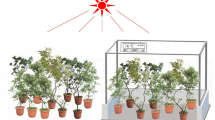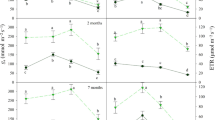Abstract
We studied the effects of artificial soil frost on cambial activity and xylem formation on 47-year-old Norway spruce [Picea abies (L.) Karst.] trees grown on medium fertile site type (with moraine soil) in eastern Finland (62°42′N; 29°45′E). Different soil frost treatments applied were: (1) natural snow accumulation and melting (control, CTRL); (2) artificial removal of snow from soil surface during two consecutive winters (OPEN); and (3) snow clearing and insulation (FROST), which was in other ways similar to OPEN, but the ground was insulated in early spring to delay soil thawing. Each treatment was replicated in three blocks, and two sample trees in each plot were repeatedly microcored during growing seasons of 2006–2007 for the analysis of the onset, cessation and the duration of xylem formation. The phases of tracheid differentiation (tracheids in radial enlargement, secondary cell wall formation, and mature tracheids) were measured from the microcores of 2007. The intra-ring growth and wood density variables were analysed based on X-ray densitometry. In FROST in 2006, xylem formation started a week later than in the other treatments. In 2007, no difference was found between the treatments. The discrepancy in results between the two study years may be explained by between-years variation in weather, i.e., the winter was colder in 2005/2006 than in 2006/2007. No effects of soil frost treatments on tracheid differentiation and on most of the intra-ring growth and density variables were discovered. Our results suggest that the delayed thawing of moraine soil may slightly affect the onset, timing and duration of xylem formation in Norway spruce. However, the effects of delayed soil frost may depend also on the soil type and become more evident with increasing water holding capacity of the soil.







Similar content being viewed by others
References
Begum S, Nakaba S, Oribe Y, Kubo T, Funada R (2010) Cambial sensitivity to rising temperatures by natural condition and artificial heating from late winter to early spring in the evergreen conifer Cryptomeria japonica. Trees 24:43–52
Bergsten U, Lindeberg J, Rindby A, Evans R (2001) Batch measurements of wood density on intact or prepared drill cores using x-ray microdensitometry. Wood Sci Technol 35:435–452
Cajander AK (1949) Forest types and their significance. Acta For Fenn 56:1–71
Creber GT, Chaloner WG (1984) Influence of environmental factors on the wood structure of living and fossil trees. Bot Rev 50(4):357–447
Deslauriers A, Rossi S, Anfodillo T, Saracino A (2008) Cambial phenology, wood formation and temperature thresholds in two contrasting years at high altitude in southern Italy. Tree Physiol 28:863–871
Drebs A, Norlund A, Karlsson P, Helminen J, Rissanen P (2002) Climatological statistics of Finland 1971–2000 (in Finnish). Finnish Meteorological Institute, Helsinki
Forster T, Schweingruber FH, Denneler B (2000) Increment puncher––a tool for extracting small cores of wood and bark from living trees. Iawa J 21:169–180
Gričar J (2007) Xylo- and phloemogenesis in silver fir (Abies alba Mill.) and Norway spruce (Picea abies (L.) Karst.). Studia Forestalia Slovenica. Professional and Scientific Works 132. Slovenian Forestry Institute, Ljubljana, p 106
Hall SM, Milburn JA (1973) Phloem transport in Ricinus: its dependence on the water balance of the tissues. Planta 109:1–10
Hänninen P, Lintinen P, Lojander S, Sutinen R (2000) Suomen maaperän vedenjohtavuus. Water conductivity of Finnish soils (in Finnish). Vesitalous 6(2000):16–19
Hänninen P, Venäläinen A, Sutinen R (2005) Maaperän jäätyminen ja vesipitoisuusmuutokset talvikautena. Soil freezing and the changes in water content of soil during winter (in Finnish). Vesitalous 1(2005):28–32
Henttonen H, Mäkinen H, Nöjd P (2009) Seasonal dynamics of the radial increment of Scots pine and Norway spruce in the southern and middle boreal zones in Finland. Can J For Res 39:606–618
Hölttä T, Vesala T, Sevanto S, Perämäki M, Nikinmaa E (2006) Modeling xylem and phloem water flows in trees according to cohesion theory and Münch hypothesis. Trees 20:67–78
Jylhä K, Ruosteenoja K, Räisänen J, Venäläinen A, Tuomenvirta H, Ruokolainen L, Saku S, Seitola T (2009) The changing climate in Finland: estimates for adaptation studies (in Finnish with extended abstract in English). ACCLIM project report 2009. https://helda.helsinki.fi/handle/10138/15711. Accessed 28 April 2011
Kellomäki S, Maajärvi M, Strandman H, Kilpeläinen A, Peltola H (2010) Model computations on the climate change effects on snow cover, soil moisture and soil frost in the boreal conditions over Finland. Silva Fenn 44:213–233
Kirdyanov A, Hughes M, Vaganov E, Schweingruber F, Silkin P (2003) The importance of early summer temperature and date of snow melt for tree growth in the Siberian Subarctic. Trees 17:61–69
Larson PR (1994) The vascular cambium: development and structure. Springer series in wood science. Springer-Verlag, Berlin, p 725
Mäkinen H, Nöjd P, Saranpää P (2003) Seasonal changes in stem radius and production of new tracheids in Norway spruce. Tree Physiol 23:959–968
Mäkinen H, Seo J-W, Nöjd P, Schmitt U, Jalkanen R (2008) Seasonal dynamics of wood formation: a comparison between pinning, microcoring and dendrometer measurements. Eur J Forest Res 127:235–245
Maljanen M, Alm J, Martikainen PJ, Repo T (2010) Prolongation of soil frost resulting from reduced snow cover increases nitrous oxide emissions from boreal forest soil. Boreal Env Res 15:34–42
Mellander PE, Stahli M, Gustafsson D, Bishop K (2006) Modelling the effect of low soil temperatures on transpiration by Scots pine. Hydrol Process 20:1929–1944
Nöjd P, Henttonen HM, Mäkinen H (2008) Increment cores from the Finnish National Forest Inventory as a source of information for studying intra-annual wood formation. Dendrochronologia 26:133–140
Peltola H, Kilpeläinen A, Sauvala K, Räisänen T, Ikonen V-P (2007) Effects of early thinning regime and tree status on the radial growth and wood density of Scots pine. Silva Fenn 41(3):489–505
Plomion C, Leprovost G, Stokes A (2001) Wood formation in trees. Plant Physiol 127:1513–1523
Repo T, Kalliokoski T, Domisch T, Lehto T, Mannerkoski H, Sutinen S, Finér L (2005) Effects of timing of soil frost thawing on Scots pine. Tree Physiol 25(8):1053–1062
Repo T, Sutinen S, Nöjd P, Mäkinen H (2007) Implications of delayed soil thawing on trees: a case study of a Picea abies stand. Scand J Forest Res 22(2):118–127
Repo T, Lehto T, Finér L (2008) Delayed soil thawing affects root and shoot functioning and growth in Scots pine. Tree Physiol 28:1583–1591
Repo T, Roitto M, Sutinen S, Manner M, Jyske T, Mäkinen H, Nöjd P, Finér L (2009) Does the removal of the snow layer enhance the adverse effects of soil frost on Picea abies (L.) Karst.? In: Himmelbauer M, Loiskandl W (eds) RootRAP: 7th ISRR Symposium Root Research and Applications, 4 p
Repo T, Roitto M, Sutinen S (2011) Does the removal of snowpack and the consequent changes in soil frost affect the physiology of Norway spruce needles? Environ Exp Bot 72(3):387–396
Rivkina EM, Friedmann EI, McKay CP, Gilichinsky DA (2000) Metabolic activity of permafrost bacteria below the freezing point. Appl Environ Microbiol 66:3230–3233
Rossi S, Deslauriers A, Morin H (2003) Application of the Gompertz equation for the study of xylem cell development. Dendrochronologia 21(1):33–39
Rossi S, Deslauriers A, Anfodillo T, Morin H, Saracino A, Motta R, Borghetti M (2006) Conifers in cold environments synchronize maximum growth rate of tree-ring formation with day length. New Phytol 170:301–310
Rossi S, Deslauriers A, Gričar J, Seo JW, Rathgeber CBK, Anfodillo T, Morin H, Levanič T, Oven P, Jalkanen R (2008) Critical temperatures for xylogenesis in conifers of cold climates. Global Ecol Biogeogr 17:696–707
Salminen H (2009) The effect of temperature on height growth of Scots pine in northern Finland. Dissertationes Forestales 96, University of Helsinki
Savidge RA (2003) Tree growth and wood quality. In: Barnett JR, Jeronimidis G (eds) Wood quality and its biological basis. Blackwell, Oxford, UK, pp 1–29
Saxe H, Cannell MGR, Johnsen B, Ryan MG, Vourlitis G (2001) Tree and forest functioning in response to global warming. New Phytol 149:369–399
Schlyter P, Stjernquist I, Bärring L, Jönsson AM, Nilsson C (2006) Assessment of the impacts of climate change and weather extremes on boreal forests in northern Europe, focusing on Norway spruce. Clim Res 31:75–84
Seppälä R, Buck A, Katila P (eds) (2009) Adaptation of Forests and People to Climate Change. A Global Assessment Report. IUFRO World Series, vol 22. International Union of Forest Research Organizations (IUFRO), Helsinki, 224 p
Sugimoto A, Yanagisawa N, Naito D, Fujita N, Maximov TC (2002) Importance of permafrost as a source of water for plants in east Siberian taiga. Ecol Res 17:493–503
Sundberg B, Uggla C, Tuominen H (2000) Cambial growth and auxin gradients. In: Savidge RA, Barnett JR, Napier R (eds) Cell and molecular biology of wood formation. BIOS Scientific publishers Ltd, Oxford, UK, pp 169–188
Sutinen R, Vajda A, Hänninen P, Sutinen M-L (2009) Significance of snowpack for root-zone water and temperature cycles in subarctic Lapland. Arct Antarct Alp Res 41:373–380
Tapio (2006) Hyvän metsänhoidon suositukset. Recommendations for good silviculture (in Finnish). Metsäkustannus Oy, Helsinki, p 100
Turcotte A, Morin H, Krause C, Deslauriers A, Thibeault-Martel M (2009) The timing of spring rehydration and its relation with the onset of wood formation in black spruce. Agric Forest Meteorol 149:1403–1409
Turner NC, Jarvis PG (1975) Photosynthesis in Sitka spruce (Picea sitchensis (Bong.) Carr.). IV. Response to soil temperature. J Appl Ecol 12:561–576
Vaganov EA, Hughes MK, Kirdyanov AV, Schweingruber FH, Silkin PP (1999) Influence of snowfall and melt timing on tree growth in subarctic Eurasia. Nature 400:149–151
Venäläinen A, Tuomenvirta H, Heikinheimo M, Kellomäki S, Peltola H, Strandman H, Väisänen H (2001) Impact of climate change on soil frost under snow cover in a forested landscape. Clim Res 17:63–72
Acknowledgments
We thank Eva Torres Nuñez, Urho Kettunen, Eija Koljonen, Seija Repo, Hannu Koivunen, and Raino Lievonen at the Forest Research Institute, and Jarmo Pennala at the University of Eastern Finland, School of Forest Sciences, for their technical assistance. This study was funded by the Academy of Finland (projects 115650 and 124390) and the Finnish Forest Research Institute (projects 3394, 3489, and 3519).
Author information
Authors and Affiliations
Corresponding author
Additional information
Communicated by E. Beck.
Rights and permissions
About this article
Cite this article
Jyske, T., Manner, M., Mäkinen, H. et al. The effects of artificial soil frost on cambial activity and xylem formation in Norway spruce. Trees 26, 405–419 (2012). https://doi.org/10.1007/s00468-011-0601-7
Received:
Revised:
Accepted:
Published:
Issue Date:
DOI: https://doi.org/10.1007/s00468-011-0601-7




